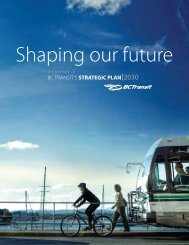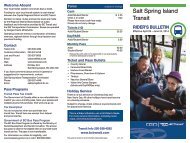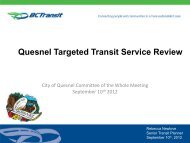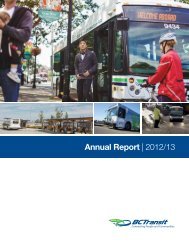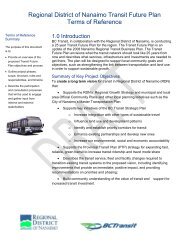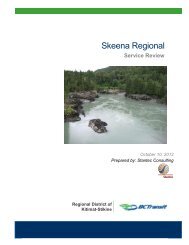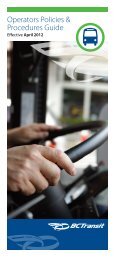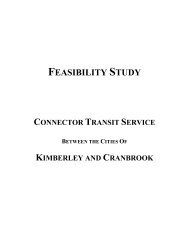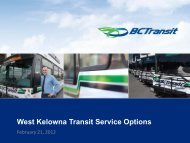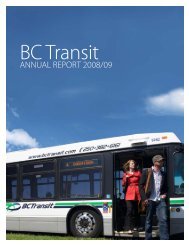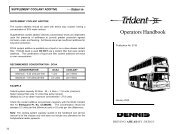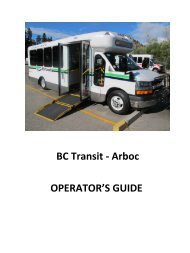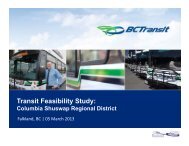- Page 1 and 2: BC Transit - Air Brake Course Prese
- Page 3 and 4: BC Transit - Air Brake Course 1. Ai
- Page 5 and 6: BC Transit - Air Brake Course 1. Ai
- Page 7 and 8: BC Transit - Air Brake Course 2. De
- Page 9 and 10: The final factor that will determin
- Page 11 and 12: Weight - Speed - Distance When weig
- Page 13 and 14: Perception Time (See-Think) Percept
- Page 15 and 16: 4/10 sec. Brake Lag (mechanical lag
- Page 17 and 18: Stopping Distance…(total stopping
- Page 19 and 20: BC Transit - Air Brake Course 2. De
- Page 21 and 22: Apply the principal from the previo
- Page 23 and 24: Using Compressed Air to Our Advanta
- Page 25 and 26: BC Transit - Air Brake Course 2. De
- Page 27 and 28: Combining mechanical advantage to a
- Page 29 and 30: As the driver applies the brake ped
- Page 31 and 32: Review Questions: Section 1 1) What
- Page 33: BC Transit - Air Brake Course 3. Fi
- Page 37 and 38: One-way Check Valve The one-way che
- Page 39 and 40: Air Lines • Air lines link compre
- Page 41 and 42: Safety Valve The Reservoirs One-way
- Page 43 and 44: Air Gauges 60 50 40 70 80 85 90 100
- Page 45 and 46: BC Transit - Air Brake Course 3. Fi
- Page 47 and 48: The Foot Valve The foot valve contr
- Page 49 and 50: The Foundation Brakes: Brake Chambe
- Page 51 and 52: Automatic Slack Adjusters Pre-Trip
- Page 53 and 54: Brake Chambers and Slack Adjusters
- Page 55 and 56: BC Transit - Air Brake Course 3. Fi
- Page 57 and 58: Review Questions: Section Three 1)
- Page 59 and 60: BC Transit - Air Brake Course 4. Ba
- Page 61 and 62: No. 2 GOVERNOR: tells compressor wh
- Page 63 and 64: No. 4 AIR LINES: link air from one
- Page 65 and 66: No. 11 BRAKE SHOES AND LININGS: sho
- Page 67 and 68: No. 13 SLACK ADJUSTER: provides a m
- Page 69 and 70: No. 15 BRAKE CHAMBER: part of force
- Page 71 and 72: Quick Release Valve and Stop Light
- Page 73 and 74: The Relay Valve The relay valve pro
- Page 75 and 76: In this diagram, the dark green lin
- Page 77 and 78: • Because the relay valve accesse
- Page 79 and 80: BC Transit - Air Brake Course 4. Ba
- Page 81 and 82: A spring type park brake serves thr
- Page 83 and 84: However, some valves may be designe
- Page 85 and 86:
Park Brake and Service Brake Releas
- Page 87 and 88:
Park Brake Applied - Service Brake
- Page 89 and 90:
Mechanical Release of the Park Brak
- Page 91 and 92:
“Maxi-Brake” type Park Brake Th
- Page 93 and 94:
“Maxi-Brake” Operation (single
- Page 95 and 96:
Park brake systems with double cont
- Page 97 and 98:
Park Brake Emergency Functions... 1
- Page 99 and 100:
BC Transit - Air Brake Course 4. Ba
- Page 101 and 102:
No. 6 LOW AIR WARNING DEVICE: activ
- Page 103 and 104:
No. 8 RELAY VALVE: provides quicker
- Page 105 and 106:
Review of Section Four 6) Why is it
- Page 107 and 108:
BC Transit - Air Brake Course 5. Ot
- Page 109 and 110:
BC Transit - Air Brake Course 5. Ot
- Page 111 and 112:
BC Transit - Air Brake Course 5. Ot
- Page 113 and 114:
BC Transit - Air Brake Course 5. Ot
- Page 115 and 116:
ATC (Automatic Traction Control)
- Page 117 and 118:
Long Stroke Push Rods Many new air
- Page 119 and 120:
Disc Brakes Callipers Rotor …oper
- Page 121 and 122:
Wedge Brakes This type of brake use
- Page 123 and 124:
Section Six Single Circuit Tractor
- Page 125 and 126:
Parts of the Trailer (van style) 1)
- Page 127 and 128:
The “Fifth Wheel” The fifth whe
- Page 129 and 130:
Hooking Up (Step 2) A visual inspec
- Page 131 and 132:
Charging the Trailer Brake Reservoi
- Page 133 and 134:
The Semi-Trailer Ready for its Pre-
- Page 135 and 136:
Tractor-Trailer Trailer Air Brake S
- Page 137 and 138:
Introduction to Valves and Componen
- Page 139 and 140:
The Hand Valve The Hand Valve is mo
- Page 141 and 142:
The Tractor Protection Valve The Tr
- Page 143 and 144:
Accidental Hand Valve Application (
- Page 145 and 146:
The Trailer Supply /Delivery Line T
- Page 147 and 148:
The Emergency Relay Valve The Emerg
- Page 149 and 150:
Foot Valve Application (trailer con
- Page 151 and 152:
Emergency Functions The following s
- Page 153 and 154:
Supply Line Rupture (trailer intact
- Page 155 and 156:
Supply Line Rupture (handling the s
- Page 157 and 158:
Service Line Rupture (continued) 1)
- Page 159 and 160:
Loss of Main Reservoir Air In this
- Page 161 and 162:
Supply & Service Lines Crossed (air
- Page 163 and 164:
Three Tests to Confirm Emergency Re
- Page 165 and 166:
Three Tests to Confirm Emergency Re
- Page 167 and 168:
Review Questions Section Six (Tract
- Page 169 and 170:
BC Transit - Air Brake Course 7. Du
- Page 171 and 172:
The Purpose of Dual Air Systems Dua
- Page 173 and 174:
Identifying Primary and Secondary C
- Page 175 and 176:
Primary and Secondary Systems (cont
- Page 177 and 178:
The Simple Dual Circuit System One-
- Page 179 and 180:
Secondary Air Loss (Foot Valve Appl
- Page 181 and 182:
Adding the Park Brake (spring brake
- Page 183 and 184:
Primary Air Loss and Park Brake Fun
- Page 185 and 186:
Enter the Modulator Valve The modul
- Page 187 and 188:
The Modulator Valve (secondary air
- Page 189 and 190:
The Modulator Valve (primary air lo
- Page 191 and 192:
The Modulator Valve (primary air lo
- Page 193 and 194:
Dual Air System Summary 1) The purp
- Page 195 and 196:
BC Transit - Air Brake Course 8. Du
- Page 197 and 198:
Combination Truck and Trailer with
- Page 199 and 200:
SYSTEM PARK TRAILER SUPPLY TRACTOR
- Page 201 and 202:
Combination Truck and Trailer (Supp
- Page 203 and 204:
Combination Truck and Trailer (mixe
- Page 205 and 206:
Combination Truck and Trailer (Prim
- Page 207 and 208:
Section Review - Dual Air - Tractor
- Page 209 and 210:
T-75 Off Highway System - Single Un
- Page 211 and 212:
L-75 Off Highway Combination with S
- Page 213 and 214:
Schedule SX Trailer (spring equippe
- Page 215:
Thank you for viewing this Air Brak



